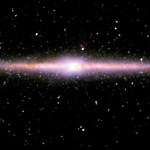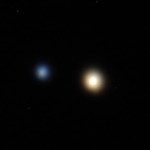pulsars
The "Physical Applications of Millisecond Pulsars" conference is under way at the Aspen Center for Physics, going through thursday when the X-Games take over.
The meeting started with surveys of current observational and instrumentation projects, in particular the amazing serendipitous discoveries being made by NASA's Fermi γ-ray observatory, in conjunction with ground based radio telescopes, and the new observatories being built.
This was followed by a session on pulsar magnetospheric physics, optical companions to pulsars and other goodies.
Today we get tests of theories of gravity, and…
On Starts With a Bang, Ethan Siegel explains that although we see the full range of spectral classes in the night sky—from cool red M stars to blazing blue O's—75% of nearby stars "are the reddest, coolest, M-class stars, including the closest star to us." Only 4.2 light-years away, Proxima Centauri "is invisible even with binoculars, and even with dark skies, a small, 3" telescope would unable to find it." Yet O and B class stars, despite being much rarer and much more distant, are so luminous that they can't be missed. Brightness can be deceiving—even when looking at entire galaxies and…
Like the stars she studies, Nifty Fifty Speaker and astrophysicist Maura McLaughlin has reached some lofty heights in her young career as she works to shed further light on the Universe and the physical laws governing it, including Einstein's theory of relativity. Maura is an assistant astrophysics professor at West Virginia University where her work mainly involves researching neutron stars - burned out remnants of stars known as pulsars that are formed in supernova explosions following the collapse of massive evolved stars.
"These exotic objects are more massive than the Sun, and can spin…
Alright, startswithabang-ers, Ben, my most avid commenter, saw me online while I was eating breakfast this morning, and pointed me to this new press release. Now, before you get started clicking on everything, the guy who the release is about is Brian Gaensler, who's a really nice guy, lives in Australia, whom I met at the AAS (American Astronomical Society) meeting in Austin, TX last month. Bryan's also brilliant.
Basically, what he did was he said, "well, we know what the rough density of hot gas in our galaxy is, and we can measure the timing of these pulsars to extraordinary accuracy."…
Last year, I had just finished my Ph.D. studies, and had moved to Madison, WI to teach introductory physics at the University of Wisconsin. I was working on this paper, and when I submitted it, I got a phone call from New Scientist magazine's space division.
Fast-forward two weeks, and I find this article online, where I got to see my name in print:
Now, scientists led by Ethan Siegel of the University of Wisconsin, in Madison, US, have come up with a new way to potentially reveal blobs of dark matter drifting nearby and perhaps even pin down what it is once and for all.
And I thought to…


